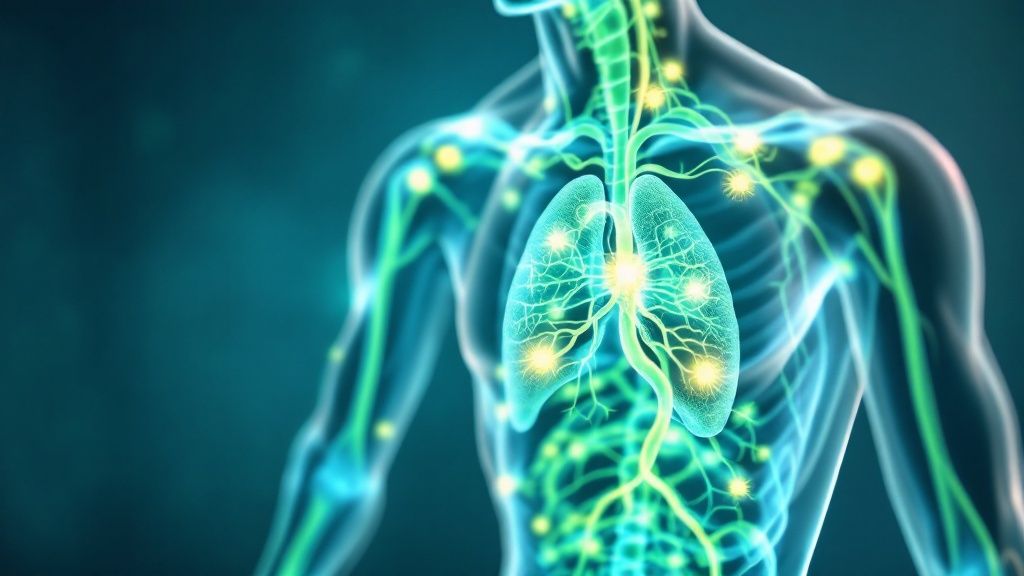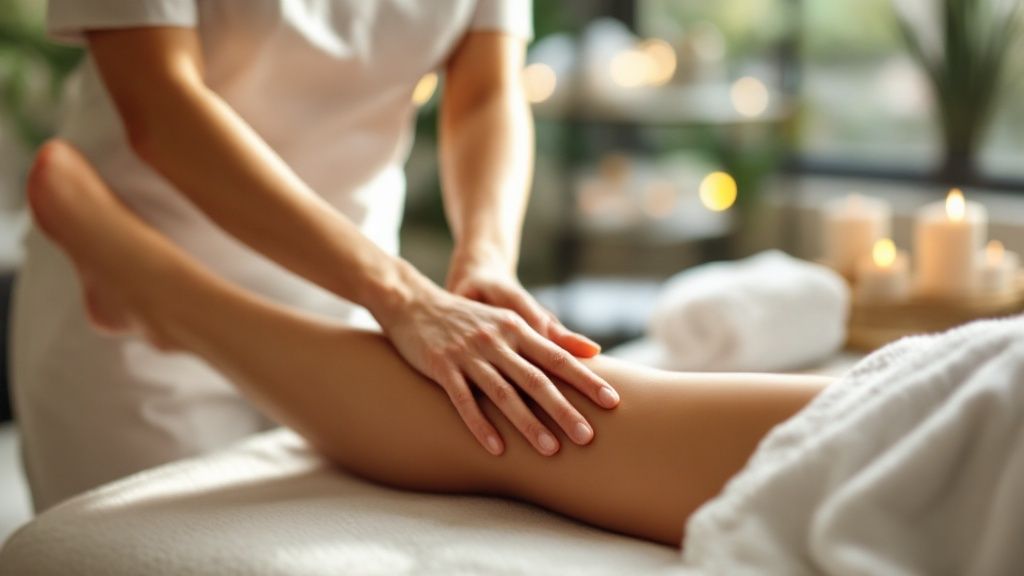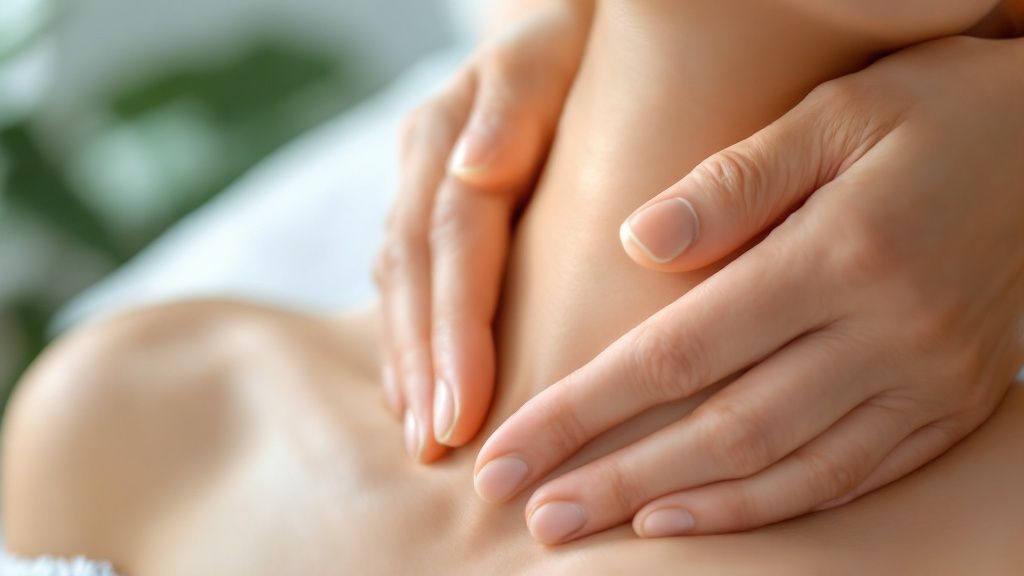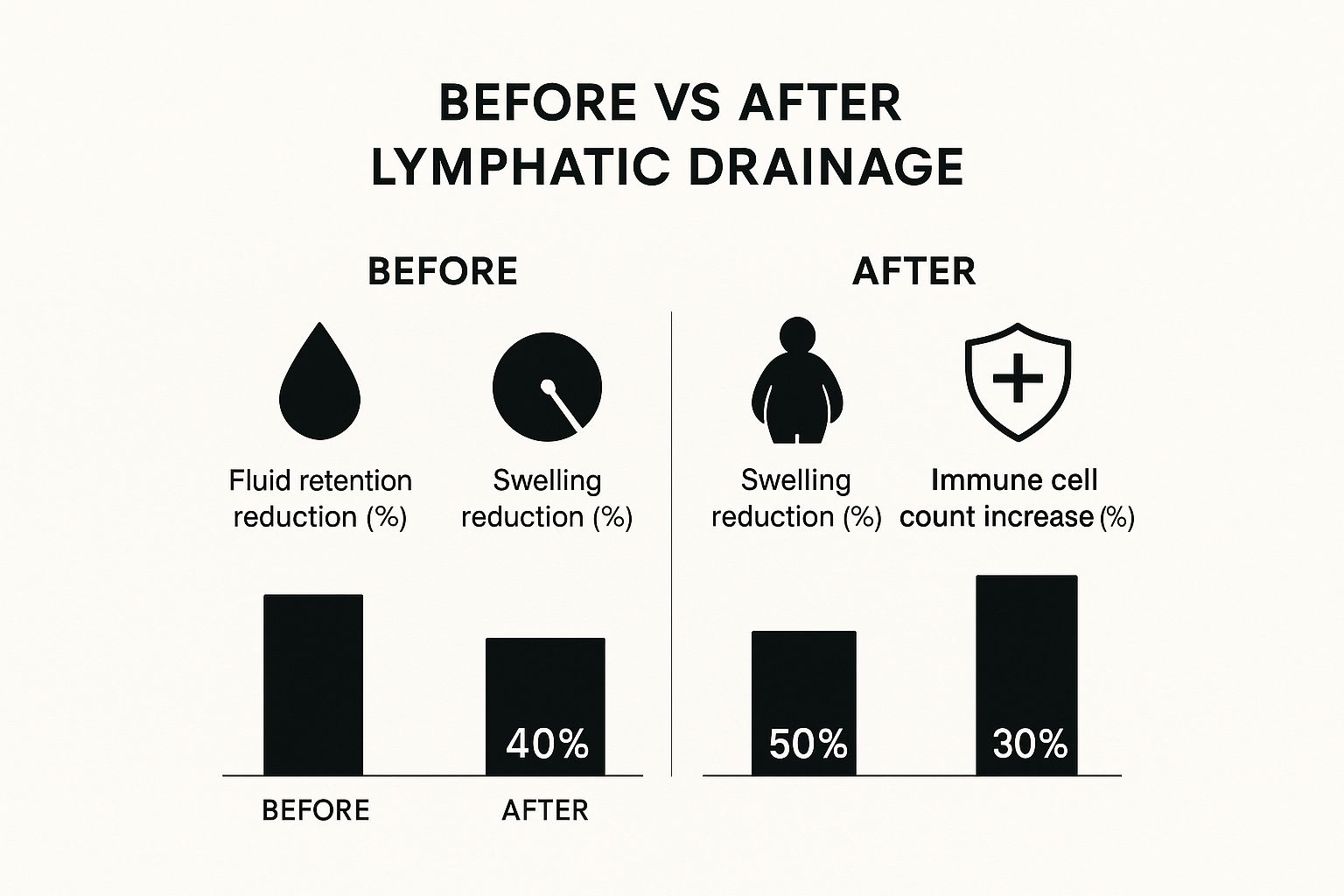At its core, lymphatic drainage therapy helps your body do what it's designed to do, just better. The main goals are to reduce swelling, speed up recovery after surgery, and give your immune system a helping hand. Think of it as empowering your body’s natural cleanup crew to work more efficiently, flushing out all the …
At its core, lymphatic drainage therapy helps your body do what it's designed to do, just better. The main goals are to reduce swelling, speed up recovery after surgery, and give your immune system a helping hand. Think of it as empowering your body’s natural cleanup crew to work more efficiently, flushing out all the gunk and excess fluid.
What Is Lymphatic Drainage and How It Works

Let’s use an analogy. Picture your body as a busy city. Your lymphatic system is the unsung hero—the sanitation and recycling department working around the clock. This complex network of vessels and nodes is constantly collecting cellular trash, toxins, and extra fluid from every single neighborhood.
But here’s the catch. Your circulatory system has the heart, a powerful pump that keeps blood moving. The lymphatic system doesn't have its own pump; it relies on your everyday muscle movements to push fluid along. When that flow gets bogged down from surgery, an illness, or even just being sedentary, that "trash" starts to pile up. This is what leads to that tell-tale puffiness, feeling sluggish, and a less-than-stellar immune response.
Lymphatic drainage is a highly specialized, gentle therapy designed to get that fluid moving again. It’s nothing like a deep-tissue massage. Instead, it involves light, rhythmic strokes that work with your body's natural lymphatic flow, not against it.
The whole point is to gently nudge the system, clearing out the congestion so your internal cleanup crew can get back to work.
The Science Behind The Touch
The technique behind lymphatic drainage is deceptively simple but incredibly precise. A trained therapist uses specific, light hand movements directly on the skin, always following the natural map of your lymphatic pathways. This gentle stretching of the skin is just enough to coax the tiny lymphatic vessels right underneath to open up and work more effectively.
This careful process accomplishes a few critical tasks:
- Redirects Fluid: It skillfully guides stagnant fluid away from swollen areas and toward healthy lymph nodes that can process it.
- Decongests Pathways: The rhythmic, wave-like motions help clear out blockages, allowing waste to be filtered and eliminated.
- Boosts Immunity: By improving lymph circulation, it helps transport your immune cells where they need to go, ready to fight off invaders.
Imagine you're a traffic controller gently clearing a jam on a major highway. You aren't forcing the cars through with a bulldozer; you're creating a clear, open path for traffic to start flowing smoothly again. That's exactly what lymphatic drainage does for your body.
To really grasp how this therapy helps, it’s useful to understand the system it supports. You can learn more about the lymphatic system's function in our detailed guide. By giving this vital network the support it needs, the therapy unlocks all the benefits we're about to dive into.
The Core Health Benefits of Lymphatic Drainage
When you get your body’s natural cleanup crew working more efficiently, you start to see some real, tangible health improvements. These aren't just vague wellness claims; they're the direct results of a system that's finally functioning at its peak.
Say Goodbye to Swelling and Fluid Retention
The most celebrated benefit is, without a doubt, a major reduction in swelling and fluid retention.
When fluid gets stuck in your tissues, it creates that uncomfortable puffiness we call edema. You see this a lot after surgery, an injury, or with certain chronic health conditions. Lymphatic drainage acts like a gentle but firm guide, ushering that excess fluid back into circulation where your body can finally process and get rid of it.
This is an absolute game-changer for anyone recovering from surgery. The body’s natural response to a procedure is inflammation, which often leads to persistent swelling that can really slow down the healing process.
By manually stimulating the lymphatic vessels, this therapy helps clear out that fluid buildup. This not only eases pressure and pain but also creates a much better environment for your tissues to repair themselves. The result? It can seriously shorten recovery times.
Fortifying Your Immune Defenses
Think of your lymphatic system as the command center for your immune response. It’s responsible for moving white blood cells—your body's front-line soldiers—to wherever they're needed to fight off invaders. A sluggish system means a delayed response, leaving you more vulnerable to getting sick.
One of the most powerful lymphatic drainage benefits is its ability to strengthen this internal army.
By improving the circulation of lymph, the therapy ensures immune cells can travel freely and quickly throughout your body. This heightened surveillance allows your system to spot and neutralize threats like bacteria and viruses far more effectively. It’s like upgrading your body’s security system from a slow, grainy feed to a high-definition, real-time network.
To give you a clearer picture, here’s a quick summary of the key benefits.
Key Benefits of Lymphatic Drainage at a Glance
This table breaks down the main ways lymphatic drainage can support your health, from physical recovery to aesthetic improvements.
| Benefit Category | Specific Outcome | Who It Helps Most |
|---|---|---|
| Physical Recovery | Reduces post-operative swelling (edema) and pain. | Individuals recovering from surgery, athletes with injuries. |
| Immune Support | Enhances circulation of white blood cells for a stronger immune response. | People prone to frequent colds, those with sluggish systems. |
| Detoxification | Facilitates the removal of metabolic waste and toxins from tissues. | Anyone feeling "sluggish" or aiming for a system reset. |
| Aesthetic Enhancement | Minimizes facial puffiness, under-eye bags, and improves skin clarity. | People seeking a natural way to enhance skin health and tone. |
| Chronic Conditions | Manages symptoms of lymphedema, fibromyalgia, and chronic fatigue. | Patients with diagnosed lymphatic or inflammatory conditions. |
As you can see, the applications are incredibly diverse, touching on nearly every aspect of well-being.
Enhancing Your Skin's Health and Glow
The benefits aren't just internal. People are often amazed by the aesthetic effects of lymphatic drainage, especially for the face and skin. The same fluid retention that causes swelling in your limbs can lead to facial puffiness, under-eye bags, and a dull-looking complexion.
A gentle lymphatic massage on the face helps drain this stagnant fluid, revealing more defined facial contours and getting rid of that tired look. By efficiently clearing toxins and cellular waste from the skin, it also promotes a brighter, clearer complexion. Many people report a noticeable reduction in breakouts and a much healthier glow.
- Reduces Facial Puffiness: Helps define the jawline and cheekbones by clearing away trapped fluid.
- Improves Skin Tone: Boosts circulation, bringing fresh oxygen and nutrients to your skin cells.
- Promotes a Clear Complexion: Assists in flushing out the toxins that can contribute to acne and dullness.
This gentle therapy isn't just anecdotal; it has proven its worth in clinical settings. Manual lymphatic drainage (MLD), a highly specialized technique, is incredibly effective at reducing limb swelling for patients managing lymphedema or recovering from surgery. Studies have shown that when MLD is paired with compression therapy, it can lead to a significant reduction in the size and volume of lymphatic malformations, a major cause of chronic swelling. You can find more details about these lymphatic massage findings on carolinapintos.com.
Ultimately, lymphatic drainage fits perfectly into a bigger picture of wellness. To better understand how different health practices can work together, it's worth exploring a holistic wellness approach.
Easing Chronic Pain and Fighting Fatigue

While most people associate lymphatic drainage with reducing visible swelling, one of its most powerful benefits is its ability to quiet chronic pain and combat deep, persistent fatigue. This gentle therapy can be a game-changer for anyone dealing with the relentless discomfort of conditions like fibromyalgia, arthritis, or chronic fatigue syndrome.
At the heart of these conditions is often widespread inflammation. Imagine a constant "alarm bell" ringing throughout your body, triggering a frustrating cycle of pain, stiffness, and utter exhaustion. The lymphatic system is designed to silence that alarm by clearing out the very substances that keep it ringing—things like metabolic waste and inflammatory proteins.
But when the system gets sluggish, these irritants get stuck in your tissues, leading to those familiar aches and tenderness. Lymphatic drainage gives the system a much-needed nudge, helping to gently flush these substances out. This can significantly calm the body's inflammatory response, often resulting in less pain and better mobility.
Soothing the Nervous System to Break the Pain Cycle
Chronic pain isn't just physical; it puts your entire nervous system on high alert, 24/7. The gentle, rhythmic motions of lymphatic drainage have a profoundly calming effect, helping to dial down that heightened state.
This soothing touch encourages your body to shift from the stressed "fight-or-flight" mode into a relaxed "rest-and-digest" state. That transition is absolutely critical for managing pain.
By calming the nervous system, lymphatic drainage can help lower the perception of pain and ease the muscle tension that so often accompanies chronic conditions. It helps break that vicious cycle where pain causes stress, and stress just makes the pain worse.
A calmer nervous system also paves the way for better sleep, which is fundamental for cellular repair and keeping pain levels in check. In fact, many people report that a good night's sleep is one of the first and most welcome changes they notice after a session. Exploring different avenues for natural chronic pain relief can give you a more holistic toolkit for managing these conditions.
Boosting Energy by Clearing Cellular Waste
That bone-deep fatigue that comes with many chronic illnesses isn't just about being tired. It’s a profound lack of energy that gets in the way of everyday life. This exhaustion is often tied to a buildup of metabolic waste at a cellular level, which literally bogs down your body's ability to produce energy.
Lymphatic drainage tackles this head-on by giving your body’s natural detoxification process a boost. By getting the lymph moving, it helps clear out the cellular "sludge" that makes you feel so lethargic.
This isn't just theory; it's backed by a solid body of research. A comprehensive review of 20 different studies spanning three decades found that lymphatic drainage therapy consistently raised pain thresholds and lessened fatigue symptoms in patients with chronic conditions. It's a significant finding for anyone struggling to get their energy back. You can dive into the specifics and read the full research about these findings to see the data for yourself.
By lightening the toxic load on your cells, lymphatic drainage helps restore your vitality from the inside out, offering a real path toward renewed energy and a better quality of life.
Averting Long-Term Tissue Damage
While most people think of lymphatic drainage for immediate swelling relief, its real power lies in long-term, proactive care. It’s one of the most important things you can do to prevent serious tissue changes that crop up when your lymphatic system stays congested for too long.
Imagine stagnant lymph fluid as a still, murky pond. Eventually, that stagnant water changes the entire environment, leading to thick muck and overgrown weeds. A similar thing happens inside your body. When that protein-rich lymph fluid just sits there, it can kick off chronic inflammation and start to physically change the tissues around it.
This isn't just a short-term problem. If left unchecked, this stagnation can cause irreversible damage that gets in the way of your mobility, comfort, and overall quality of life.
The Downside of Stagnation
When lymphatic flow slows to a crawl, two major issues can develop over time. Grasping what these are makes it crystal clear why keeping your lymph moving is so crucial for healthy tissue.
- Fibrosis: This is a slow, creeping hardening and thickening of the skin and the tissues just beneath it. The stagnant, protein-heavy fluid basically tells the body to start producing extra collagen fibers. The result is a firm, dense, and less elastic texture that can make movement feel tight and restricted.
- Fat Accumulation: Chronic lymphatic congestion can also trigger the abnormal growth of fat cells, a process called adipose proliferation. This adds even more bulk and weight to the area, putting more strain on an already overburdened lymphatic system.
These two problems create a nasty feedback loop. The thicker the tissue gets, the harder it is for lymph to flow, which just makes the whole situation worse.
How Lymphatic Drainage Breaks the Cycle
This is where lymphatic drainage therapy comes in. It’s a powerful way to interrupt that damaging cycle before it truly takes hold. By manually getting the lymph moving, the therapy helps clear out the stagnant fluid before it can signal those long-term changes.
Think of it this way: the therapy keeps the "pond" from turning into a "swamp." By making sure fluid is always moving and being processed, it prevents the protein buildup that leads to fibrosis and unhealthy fat growth, protecting your tissues.
This preventive role is gaining more and more recognition in medical settings. For instance, unmanaged lymphedema can lead to progressive tissue hardening and fat accumulation, which can become quite debilitating. Research has shown that patients who receive manual lymphatic drainage as part of their complete therapy see a slower progression of fibrosis and reduced skin thickness compared to those who rely on compression alone. You can dig into some of the clinical findings on tissue health for more detail.
Ultimately, making lymphatic drainage a part of your wellness plan is about more than just feeling better today. It's an investment in your future, helping to keep your tissues healthy, mobile, and comfortable for the long haul.
A Look at Different Lymphatic Drainage Methods

When you start exploring lymphatic drainage, you’ll quickly find it’s not a one-size-fits-all therapy. There are several different ways to get the job done, and each one has a unique way of nudging your body’s natural detox system into gear. Knowing a bit about these options can help you have a much more productive conversation with a practitioner about what’s right for your body and your goals.
At a high level, the methods fall into two main buckets: hands-on manual techniques and those that use specialized machines. Both are designed to achieve the same goal—getting stagnant lymph fluid moving—but they approach it from different angles. The best choice often comes down to your specific condition, the area being treated, and what you’re most comfortable with.
Manual Lymphatic Drainage: The Power of Touch
Manual Lymphatic Drainage (MLD) is the classic, hands-on method you’ll see most often. This isn't your typical deep-tissue massage; in fact, it feels incredibly light. A highly trained therapist uses specific, rhythmic hand movements with just enough pressure to gently stretch the skin. This subtle action is all it takes to encourage the tiny lymphatic vessels just beneath the surface to open up and get the fluid flowing.
What makes this method so effective is its adaptability. A skilled therapist can feel for areas of congestion and adjust their technique on the spot, tailoring the session precisely to your body’s needs. Over the years, a few distinct MLD styles have emerged:
- Vodder Technique: This is often considered the original MLD method. It involves a series of gentle, circular pumping motions that are incredibly soothing and effective at stimulating lymph flow.
- Foldi Technique: A key part of managing lymphedema, this method is more strategic. The therapist works on "clearing" pathways first, then carefully redirecting fluid from congested areas toward healthy ones that can handle the load.
- Casley-Smith Technique: This approach also plays a big role in lymphedema management and uses small, repetitive circular movements with the sides of the hands.
Because of its precision, MLD is the go-to choice for delicate areas like the face and neck or for complex situations like post-surgical recovery.
At its heart, the principle is the same across all manual methods: the therapist’s hands become an intuitive tool, sensing where fluid has built up and skillfully guiding it back toward the body's drainage points.
Machine-Assisted Lymphatic Therapies: A Technological Boost
Technology also offers some powerful ways to support lymphatic health, and these are often used right alongside manual techniques. These modalities use specialized equipment to create the kind of gentle, consistent pressure that mimics the body’s natural lymphatic rhythm.
One of the most common approaches is pneumatic compression. For this, you’ll wear inflatable sleeves or garments on your arms, legs, or torso. A machine then systematically inflates and deflates different chambers within the garment, creating a gentle, wave-like squeezing motion that methodically pushes fluid upward, toward the core of your body.
Another advanced option is electro-lymphatic drainage. This therapy uses special wands that emit a mild, high-frequency vibration. When placed on the skin, this subtle energy helps break down thick, congested proteins and fluid, making it much easier for your lymphatic system to process and flush them away. It can be a real game-changer for breaking up stubborn areas of swelling that haven't responded to other methods.
Comparing Lymphatic Drainage Modalities
To help you visualize the differences, here’s a quick breakdown of the most common techniques and what they’re best suited for.
| Modality | Technique | Best For |
|---|---|---|
| Manual Lymphatic Drainage (MLD) | Gentle, rhythmic, hands-on skin stretching. Includes Vodder, Foldi, and Casley-Smith styles. | Post-surgical recovery, lymphedema management, delicate areas (face/neck), general wellness, and detoxification. |
| Pneumatic Compression | Inflatable garments create sequential, wave-like pressure on the limbs or torso. | Reducing swelling in limbs, managing lymphedema at home, enhancing athletic recovery, improving circulation. |
| Electro-Lymphatic Drainage | High-frequency vibration from wands helps break down congested fluid and proteins. | Stubborn fluid retention, reducing inflammation, addressing fibrotic tissue, and enhancing manual drainage results. |
Ultimately, choosing between manual and machine-assisted therapy isn't an either/or decision. Many of the most effective treatment plans actually combine different methods to get the best possible results, creating a personalized approach that helps your lymphatic system function at its absolute best.
How to Find a Qualified Therapist
When it comes to lymphatic drainage, choosing the right professional is everything. This isn't just any massage; it's a highly specialized therapy that requires a deep understanding of the body's delicate lymphatic pathways. To get the real benefits and stay safe, you need someone with specific training.
The first thing to look for is their credentials. The gold standard in this field is a Certified Lymphedema Therapist (CLT). This certification tells you the practitioner has gone through rigorous, in-depth training on how to perform Manual Lymphatic Drainage (MLD) correctly and manage complex lymphatic conditions.
Vetting Your Practitioner
Once you've found a few potential therapists, it's smart to ask some direct questions before you book an appointment. This is your chance to get a feel for their experience and make sure they're a good fit for your specific needs, whether you're recovering from surgery or dealing with a chronic issue.
A few questions to ask:
- Could you tell me about your specific certifications in lymphatic drainage?
- How many clients have you worked with who have [mention your specific condition]?
- What does a typical first session with you look like?
Their answers should give you confidence in their ability to help you.

As you can see, proper therapy can make a huge difference in reducing fluid and swelling while boosting immune function. Finding a skilled hydro-therapist and lymphatic specialist who understands your goals is the key to unlocking these results.
During your initial visit, a good therapist will take the time to go over your full medical history and really listen to what you want to achieve before any hands-on work begins.
Got Questions? We've Got Answers
It's completely normal to have questions before trying a new therapy. Knowing what to expect from your first lymphatic drainage session can ease any nerves and help you get the most out of the experience.
What Does a Lymphatic Drainage Session Actually Feel Like?
If you're expecting a deep, muscle-kneading massage, you might be surprised. Lymphatic drainage is a world apart—it's incredibly gentle.
The therapist uses very light, rhythmic, and almost feather-like strokes across the surface of your skin. The pressure is just enough to gently stretch the skin, which is exactly what’s needed to encourage the tiny lymphatic vessels just underneath to get moving. There’s no pain, no intense pressure. In fact, it’s so calming that many people drift off to sleep on the table.
How Often Should I Come in for Treatment?
There's no one-size-fits-all answer here; it really comes down to your body and your goals. If you're dealing with a specific, short-term issue like post-surgical swelling, you might start with a few sessions a week and then taper off as you heal.
For managing a chronic condition like lymphedema, lymphatic drainage often becomes a regular part of your health routine. But if you're simply looking for a wellness boost or a gentle detox, coming in once or twice a month could be perfect. Your therapist will work with you to figure out the best schedule.
A Quick Word on Safety: While lymphatic drainage is safe for most people, it's not the right fit for everyone. It's generally not recommended for individuals with conditions like congestive heart failure, active infections, or a history of blood clots.
Always be sure to share your complete medical history with your therapist, and if you have any serious health concerns, it's always a good idea to check in with your doctor first.
At Healing Waters Wellness Center, our certified therapists are here to answer all your questions and create a treatment plan that's both safe and effective for you. Start your journey toward better health with us today.






